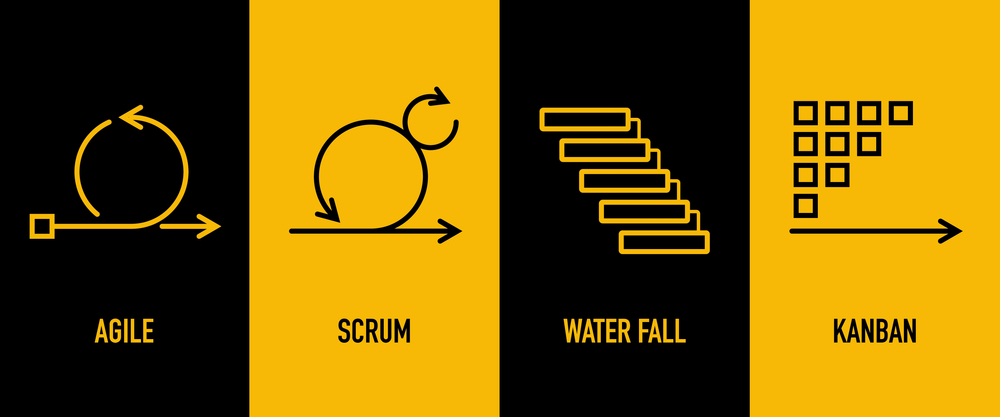Choosing the right project management methodology for the job is essential. There are so many; Agile, Waterfall, Scrum, and others. Our guide to evaluating project management methodologies will ensure you pick the perfect fit for your next project.
Choosing the right project management methodology for your team is the first step to success. But with so many different — and in some cases, overlapping — approaches to managing the complexities of any given project, how can you know which project management methodology is best?
Project managers can assist their organizations in improving how they implement projects in the most effective and efficient way while reducing risks. But this requires much more than just recognizing organizational priorities. You have to have a deeper understanding of how each project management methodology can create the greatest positive impact — and how each can derail your organization’s likelihood of project success.
Here, we outline the most popular project management methodologies (PMMs) in practice today, showing you how to evaluate which is best for your project and organization. Once developed, a process for evaluating and choosing the right project management methodology can be documented and repeated, enabling your organization to spend less time haggling over how to structure and manage your projects and more time on achieving project objectives and deliverables.
The most popular project management methodologies today
There are many well-known project management methodologies to choose from like waterfall, agile, scrum, critical path, critical chain and more. Here’s what you need to know about each.
Waterfall: Waterfall has been a mainstay project management methodology for years. It is sequential in nature and is used across many industries, most commonly in software development. It comprises static phases (requirements analysis, design, testing, implementation, and maintenance) that are executed in a specific order. Waterfall allows for increased control throughout each phase but can be highly inflexible if a project’s scope changes after it is already underway. It offers a more formal planning stage that may increase the chances of capturing all project requirements up front, reducing the loss of any key information and requirements in the initial stages.
Agile: Agile takes a significantly different approach to project management. It was initially developed for projects that require significant flexibility and speed. To achieve this, agile is composed of short delivery cycles, aka “sprints.” Agile may be best suited for projects requiring less control and real-time communication within self-motivated team settings. As a project management methodology, agile is highly interactive, allowing for rapid adjustments throughout a project. It is commonly used in software development projects in large part because it makes it easier to identify issues quickly and to make modifications early in the development process, rather than having to wait until testing is complete. Agile offers repeatable processes, reduces risk, allows for immediate feedback, provides fast turnaround, and reduces complexity.
Hybrid: While many teams will favor either waterfall or agile, the benefits of both approaches can create a case for a hybrid project management methodology solution, one in which the planning and requirements phase is undertaken under a waterfall approach and the design, develop, implement, and evaluate phases follow the agile methodology.
Critical path method: Critical path method (CPM) is a step-by-step methodology used for projects with interdependent activities. It contains a list of activities and uses a work-breakdown structure (WBS) and a timeline to complete, as well as dependencies, milestones, and deliverables. It outlines critical and noncritical activities by calculating the “longest” (on the critical path) and “shortest” (float) time to complete tasks to determine which activities are critical and which are not.
Critical chain project management: Critical chain project management (CCPM) differs from CPM in that it focuses on the use of resources within a project instead of project activities. To address potential issues with resources, buffers are built in to ensure projects are on-time and that safety is not compromised.
Six Sigma: Six Sigma was originally developed by Motorola to eliminate waste and improve processes and profits. It is data-driven and has three key components: DMAIC (define, measure, analyze, improve and control), DMADV (define, measure, analyze, design, and verify), and DFSS (Design for Six Sigma). DFSS can include the previous options, as well as others, such as IDOV (identify, design, optimize and verify). Six Sigma is sometimes debated as a methodology in the project management community.
Scrum: Scrum is named after rugby, scrum is a part of the agile framework and is also interactive in nature. “Scrum sessions” or “30-day sprints” are used to determine prioritized tasks. A scrum master is used to facilitate instead of a project manager. Small teams may be assembled to focus on specific tasks independently and then meet with the scrum master to evaluate progress or results and reprioritize backlogged tasks.
Other PMMs: In addition to the project management methodologies mentioned above, there are other PMMs to consider, including event chain methodology (ECM), crystal, feature-driven development (FDD), dynamic systems development (DSDM), adaptive software development, rational unified process (RUP), lean development (LD), Prince2 and others.
It’s important to note that there is no one solution in all cases, even within the same organization. Project management experience comes into play, and this is where a project manager’s knowledge of the pros and cons of each methodology can greatly assist organizations in successfully navigating projects in ways that allow them to maximize the potential for stakeholders.
How to effectively evaluate project management methodologies

The Project Management Institute (PMI) has developed a globally recognized standard called the Organizational Project Management Maturity Model (OPM3). This assists organizations in identifying, measuring, and improving PM capabilities and standardizing processes. It helps solidify successful project outcomes, ultimately determines best practices, and strengthens the connection between strategic planning and execution. OPM3 focuses on overall organizational strategic effectiveness and incorporates project, program, and portfolio management. In 2013 it was recognized by the American National Standards Institute (ANSI) as an American National Standard.
Within its Implementing Organizational Project Management: A Practice Guide, PMI discusses high-level processes for tailoring PMMs that organizations should carefully evaluate and use to determine which methodologies work for various projects. Decisions should also be based on factors in the PMI Methodology Tailoring Process to maximize strategic benefits.
Benefits of Organizational Project Management
It may make sense for your business to adopt OPM3, given that a primary goal of OPM3 is to achieve successful strategic alignment and successful project outcomes depend heavily on such alignment. Organizations will need to include enterprise program management offices (EPMOs) in high-level planning sessions to ensure the right methodologies are deployed for specific projects to increase productivity and customer satisfaction, gain a competitive advantage, improve cost control and communications and predict performance. Ultimately, this will improve and expedite decision-making as well as support alignment with company-wide goals.
Because of the various strengths and weaknesses of each PMM, organizations may want to consider adopting multiple project management methodologies based on the unique nature of their project, organizational makeup, and project goals. Either way, organizations need to develop standardized best practices that can be refined as various factors change. Here, the key is to figure out how a specific project aligns with company-wide objectives. Once success or failure criteria can be isolated, it’s easier to find the most suitable methodology or methodologies that will enable your organization to effectively and efficiently reach the desired business result.
Key considerations in choosing a project management methodology
Whether you lean toward Scrum, Agile, Waterfall or other methodologies, throughout evaluating methodologies, here are just a few of the numerous factors that should be carefully considered:
- Organizational strategic goals and core values
- Key business drivers
- Constraints
- Stakeholders
- Risks
- Complexity
- Project size and cost
The project management methodology assessment process
Once the assessment criteria have been factored into the decision, you need to develop a process to identify the best PMM option(s) for your specific project. This process will need to be revisited and modified from time to time to keep up with evolving business and stakeholder needs. Here are some general steps:
- Determine project drivers by identifying and weighing primary goals and priorities of the project.
- After determining project drivers, requirements and goals, identify all the criteria that a methodology will impact and vice versa.
- Identify all available/possible methodologies that are most relevant to the project.
- Spend time comparing and contrasting each PMM in relation to the project.
- Consider which methodology will yield the best results and offer the least risk.
- Gain feedback and buy-in.
- Document the methodology and rationale.
- Implement the methodology.
- Monitor and modify as required.
What to include in the project management methodology assessment
In organizational development, as well as within projects, this list of relevant assessment criteria applies. When it comes to selecting a methodology, these same criteria should also factor in. These can be broken down into internal and external criteria, with relevant subcategories for each.
Although the biggest risk factors are likely to fall within organizational capabilities and preparedness, any other criteria mentioned previously can create significant problems if they are in breach of a key project requirement.
As mentioned, PMMs are definitely not one-size-fits-all, even within the same company, project type, or industry. In one situation a specific methodology may work best, and in others, it may be more suitable to use a different project management methodology or even a hybrid approach. The same methodology is unlikely to work in the same organization on all projects; a best practice is to develop and implement a streamlined methodology assessment process (MAP) to determine the best approach for each project. Keep in mind this process itself may require reassessment and modifications as business factors change.
All content: Copyright 2018 by CIO.com—IDG Enterprise Inc., 492 Old Connecticut Path, Framingham, MA. 01701.
Similar Content:


